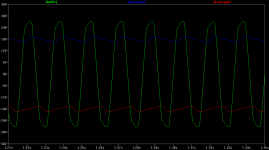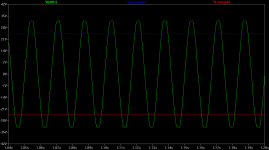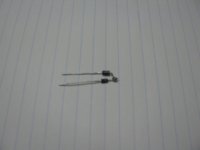Thanks MrSlim, I'll check it out but tubes? what are they for? buffering?. I need no amplification since I'm going for the O2 but still, I'll look into them.
Hmmm, sorry - the grub dac looks intressting... But, the input is limited to 16/48 on usb. I am more in search for 24/96 as a minimum without amplifier.
Brgds
Well, then you should be looking here: Yoyodyne Consulting/Audio Hardware
The YC-USB9023 is available now, for less than $100.. with variations to come...
JD
I'm ordering the parts from the BOM list. I have question for the Gain resistors R19,R23 and R17,R21. What are the most typical values to use at these locations?
Thanks.
SB
Thanks.
SB
I wonder if it's possible to use a 24V AC adapter in O2. Yes, I did read the max voltage should be 20V AC.
Since the caps (470uF/35V) and both MC7812ACT & MC7912ACT are all capable to handle 35V, I thought 24V should be ok. Have I overlooked sth?
Pls advise. Thanks!
Since the caps (470uF/35V) and both MC7812ACT & MC7912ACT are all capable to handle 35V, I thought 24V should be ok. Have I overlooked sth?
Pls advise. Thanks!
I wonder if it's possible to use a 24V AC adapter in O2.
I think the regulators would cook.
Lets say 24VAC winds up around 30VDC after the half wave rectifiers and filter caps. Ignoring line voltage fluctuations and transformer regulation increase with light loads, that would be (30VDC - 12VDC) * 0.1mA = 1.8W each with 100mA loading. But there are no heatsinks on the regulators, no space for any, and they butt right up against each other.
dumbears - something here that you could try. Lol - similar to a suggestion I got jumped on about in another thread recently
http://www.diyaudio.com/forums/power-supplies/198954-15v-ac-required-balancing-converter-board.html
You could try adding 6.2V or so zeners in series with the rectifier diodes to knock the voltage down to level that isn't so close to the voltage regulator maximum. The resulting power dissipation is more in line with what the un-heatsinked voltage regulators can handle. The zeners then share in the dissipation.
24VACrms = 34VACpeak = 68VACpeak-peak, of course. The first plot is with a 220mA load, around the max the O2 can handle, producing about +/-18VDC going into the voltage regulator chips. The second plot is with a 22mA load resulting in about 24VDC going into the regulators. The picture is how to make it work. Solder the rectifier to the zener, then stuff the free leads in the holes where the rectifier would otherwise go.
6.2V 3W zeners like this would work just fine
1N5920BG ON Semiconductor Zener Diodes
that one has a DO-41 case like the 1N4002. Zeners tend to be noisy, but at 6.2V and below the breakdown mechanism is primarily zener, which is vastly quieter than zeners above 6.2V which are primarily avalance breakdown. See the max noise denisty column in the datasheet here to get a feel for it -
http://www2.microsemi.com/datasheets/sa5-27.pdf
after 6.2V the noise density jumps from 5uV/sqrt(Hz) to 40uV/sqrt(Hz)
http://www.diyaudio.com/forums/power-supplies/198954-15v-ac-required-balancing-converter-board.html
You could try adding 6.2V or so zeners in series with the rectifier diodes to knock the voltage down to level that isn't so close to the voltage regulator maximum. The resulting power dissipation is more in line with what the un-heatsinked voltage regulators can handle. The zeners then share in the dissipation.
24VACrms = 34VACpeak = 68VACpeak-peak, of course. The first plot is with a 220mA load, around the max the O2 can handle, producing about +/-18VDC going into the voltage regulator chips. The second plot is with a 22mA load resulting in about 24VDC going into the regulators. The picture is how to make it work. Solder the rectifier to the zener, then stuff the free leads in the holes where the rectifier would otherwise go.
6.2V 3W zeners like this would work just fine
1N5920BG ON Semiconductor Zener Diodes
that one has a DO-41 case like the 1N4002. Zeners tend to be noisy, but at 6.2V and below the breakdown mechanism is primarily zener, which is vastly quieter than zeners above 6.2V which are primarily avalance breakdown. See the max noise denisty column in the datasheet here to get a feel for it -
http://www2.microsemi.com/datasheets/sa5-27.pdf
after 6.2V the noise density jumps from 5uV/sqrt(Hz) to 40uV/sqrt(Hz)
Attachments
Last edited:
I think the 24VAC would work, but as the headphone output was increased the regulators would trip their thermal protection circuits and shut down to cool.
Basically, any AC supply capable of 1) overcoming the dropout voltage of the regs and 2) not causing excessive reg power dissipation will work.
Basically, any AC supply capable of 1) overcoming the dropout voltage of the regs and 2) not causing excessive reg power dissipation will work.
Agree with this:If you are genuinely interested in the O2 as a DIY project, then it's up to you to set the output level of your source correctly or in lieu of being able to do so, then set the input gain of the O2 correctly
Pardon if I'm dropping in, I’d like to parallel two separate O2 amps to the headphone output jack of my bus-powered DAC and attempt to have each amp drive a set of high impedance (600 ohm) low sensitivity (88 db SPL at 1mW) headphones. Will it work? Gain, power, impedance, where do I start? I guess it’ll either be loud enough or - it won’t!
Im going to order parts at mouser next month, but is there a shared bom i can use at mouser so i dont have to type every part in??
And what about upgrading parts instead of stock parts??
And what about upgrading parts instead of stock parts??
Agree with this:If you are genuinely interested in the O2 as a DIY project, then it's up to you to set the output level of your source correctly or in lieu of being able to do so, then set the input gain of the O2 correctly
Dumbears isn't talking about input levels, he's talking about using a higher power supply voltage.
Im going to order parts at mouser next month, but is there a shared bom i can use at mouser so i dont have to type every part in??
If you download the BOM from NwAvGuy's(RocketScientist) website, you can copy the parts list and upload it to Mouser with their Import BOM tool that's under the Services & Tools Tab. No typing required..
And what about upgrading parts instead of stock parts??
What parts do you want to upgrade? It's unlikely to buy you anything, and NwAvGuy has already explained why he chose the Opamps that he did, and has been very thorough in his testing and design.
See BionicSniper's opinion here: http://www.diyaudio.com/forums/group-buys/194708-o2-headphone-amplifier-gb-103.html#post2755426
Last edited:
Pardon if I'm dropping in, I’d like to parallel two separate O2 amps to the headphone output jack of my bus-powered DAC and attempt to have each amp drive a set of high impedance (600 ohm) low sensitivity (88 db SPL at 1mW) headphones. Will it work? Gain, power, impedance, where do I start? I guess it’ll either be loud enough or - it won’t!
This has been discussed earlier in the thread(sorry you'll have to dig for it).
The headphones you are talking about are outside the operating parameters of the O2 and trying to do what you want to do is unlikely to work very well.
You'll need something more powerful, like the previously mentioned "The Wire" or the Twisted Pear Ventus (unfortunately out of stock at this time) which both use the LME49600 buffer.
If you download the BOM from NwAvGuy's(RocketScientist) website, you can copy the parts list and upload it to Mouser with their Import BOM tool that's under the Services & Tools Tab. No typing required..
What parts do you want to upgrade? It's unlikely to buy you anything, and NwAvGuy has already explained why he chose the Opamps that he did, and has been very thorough in his testing and design.
See BionicSniper's opinion here: http://www.diyaudio.com/forums/group-buys/194708-o2-headphone-amplifier-gb-103.html#post2755426
Thanks i have missed that.
Just better caps and non magnetic resistors
if you have symmetric V drive, balanced source then the 2 channels of one amp could be bridged for 600 Ohm cans, 2 amps to drive one headphone, requires custom cabling
2 @ 600 Ohms in parallel would only look like a 300 Ohm load, bridging doubles current demand again - so 150 Ohm equivalent load - still fine for O2
you will always get some sound, the question is how much
with bridged operation you would be able to go over 100 dB into 600 Ohm, 88 dB re 1 mW
not "Rock Out" or "Audiophile" levels - but adequate for listening at levels safe for all day use (80 dB ave, very few recordings have 20+ dB peak-to-ave)
2 @ 600 Ohms in parallel would only look like a 300 Ohm load, bridging doubles current demand again - so 150 Ohm equivalent load - still fine for O2
you will always get some sound, the question is how much
with bridged operation you would be able to go over 100 dB into 600 Ohm, 88 dB re 1 mW
not "Rock Out" or "Audiophile" levels - but adequate for listening at levels safe for all day use (80 dB ave, very few recordings have 20+ dB peak-to-ave)
Last edited:
Agree with this:If you are genuinely interested in the O2 as a DIY project, then it's up to you to set the output level of your source correctly or in lieu of being able to do so, then set the input gain of the O2 correctly
Just curious, what would be a "correct" output level of the source?
Just curious, what would be a "correct" output level of the source?
under 2.0V, which is generally what most sources output..
Actually, his comment is out of context I think, since the discussion at the time was about power supply voltages, not source voltages..
This has been discussed earlier in the thread(sorry you'll have to dig for it).
The headphones you are talking about are outside the operating parameters of the O2 and trying to do what you want to do is unlikely to work very well.
You'll need something more powerful, like the previously mentioned "The Wire" or the Twisted Pear Ventus (unfortunately out of stock at this time) which both use the LME49600 buffer.
I appreciate the alternative suggestions. I’ll look into them.
Yes, mention of this was made in post #135 along the lines of duplicating everything after the input stage or, more simply - and reluctantly, (without independent volume control), using parallel output jacks from a single O2 with maybe an NE5532 in the gain stage to handle the extra load.
After reading this forum as well as NwAvGuy’s blog articles, I didn’t really pick up that these headphones would be incompatible with the O2, in fact I rather thought the opposite. Although I was kind of wary given my headphone’s atypical specs and I do have quite limited understanding of these things. Would you mind explaining a little more how you’ve determined this?
- Home
- Amplifiers
- Headphone Systems
- The Objective2 (O2) Headphone Amp DIY Project



